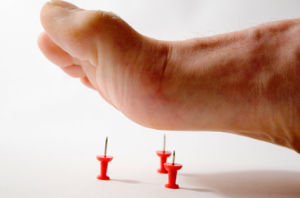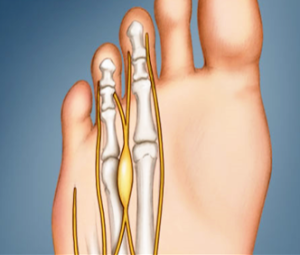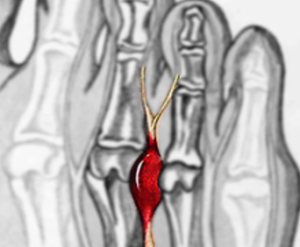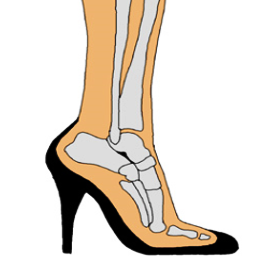Morton’s Neuroma
Morton’s Neuroma (Intermetatarsal Neuroma)
A neuroma is a thickening of nerve tissue (Perineural Fibrosis) that may develop in various parts of the body. Morton’s Neuroma are a painful condition where a benign enlargement of nerve tissue forms between the third and fourth metatarsals/toes. This thickening of the tissue around the nerve causes foot pain, odd sensations, or numbness over the ball of the foot.
various parts of the body. Morton’s Neuroma are a painful condition where a benign enlargement of nerve tissue forms between the third and fourth metatarsals/toes. This thickening of the tissue around the nerve causes foot pain, odd sensations, or numbness over the ball of the foot.
The thickening, or enlargement is the result of compression and irritation of the nerve. This compression creates enlargement of the nerve, eventually leading to permanent nerve damage.
Causes
Irritation or compression of the nerve between the ends of the metatarsals can lead to the development of a Morton’s Neuroma. Some other contributing factors in the development of a Morton’s Neuroma include;
- Trauma – injury to the area that may cause inflammation, swelling or nerve damage may lead to a Neuroma.
- Footwear – wearing shoes that cause toes to be squeezed together causing swelling and inflammation may lead to a neuroma (narrow shoes, tight shoes, poorly fitting shoes).
- Foot type – flat feet (pronation) or high arch (supinated) feet can increase changes or irritation/compression of the nerve between the metatarsals leading to a Morton’s Neuroma.
- Physical activity – repetitive stress at the ball of the foot during activities such as running can cause irritation of the nerve causing a Morton’s Neuroma.
Symptoms
Most commonly patients suffering from a Morton’s Neuroma will feel pain at the space between their 3rd and 4th toes. Other symptoms often reported by patients include;
- Tinging, burning or numbness of your toes at the ball of your foot.
- Pain between the toes and the forefoot.
- A feeling as if you are standing on a pebble in your shoe.
- Increase in pain with activity or tight fitting shoes (high heels, narrow shoes).
Treatment
A comprehensive podiatric assessment is recommended to prevent the progression of symptoms and ensure appropriate treatment is undertaken. Diagnostic imaging including a X-ray, Ultrasound and often a MRI may be required for further diagnosis. At Sydney Foot Clinic the following treatments are offered to treat Morton’s Neuroma;
- Padding/offloading – offloading excess pressure from the ball of the foot.
- Custom Orthotic therapy – prescription of a custom orthotic placed in your shoe will address any biomechanical factors and reduce irritation/compression of the nerve.

- Footwear recommendations – avoiding high heels (increase pressure on your forefoot), narrow or tight fitting shoes will reduce the symptoms of the neuroma.
- Injection therapy – specialized injections can be used to infiltrate the area surrounding the nerve to reduce inflammation and reduce compression.
- Dry Needling
- Education regarding activity changes.
- Nonsteroidal anti-inflammatory medications (NSAIDs) and Ice- help reduce the pain and inflammation.
If conservative treatment does not relieve symptoms surgery may be necessary to reduce the symptoms.
